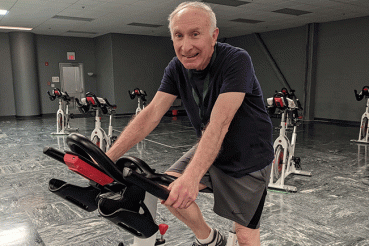At Rush, knee and hip replacements are so common they are a part of everyday life for the trained medical team. According to Vasili Karas, MD, MS, a fellowship-trained orthopedic surgeon, that’s why there’s no better place in the Chicago area — and Illinois — to have these procedures done.
“The most important thing when it comes to selecting your care provider is to find a practice that does a high volume of these procedures,” Karas explains. “There’s a lot of research on which hospitals and what kind of training results in better outcomes, and we consistently see that providers who perform more joint replacements have better outcomes. Rush University Medical Center is the No. 1 hospital in Illinois for joint replacements because we do a lot of them, and it makes us very good at it.”
Playing through the pain
For Paul Morris, 66, this common procedure was life changing. Paul has always been active and athletic, participating in sports like shot put, track and judo in his younger days and playing golf and hitting the gym as an adult.
Then, five years ago, he started to experience a tremendous pain in his left knee that he couldn’t relieve. He went to a Chicago-area hospital to have it checked out.
“I was told that I needed a knee replacement and there was nothing I could do about it,” Paul says. “I didn’t like my experience with them, so I put it off and bought about 20 different knee braces so I could keep golfing with my friends on the weekends.”
Finally, he couldn’t ignore the discomfort anymore. Between golfing, talking walks with his wife and playing with his family, he was constantly limping. When he felt that he could no longer keep up with his grandkids, he called Rush on the advice of friends and neighbors who had positive experiences with their own knee and hip replacements.
A resident of the southwest suburbs of Chicago, Paul was grateful to have the option to have the procedure performed at Rush’s Oak Park or downtown location. He and his family decided that Oak Park was more convenient for him.
Weighing the options
Paul’s care team discussed all his options, which was incredibly reassuring. “Dr. Karas listened to me; he didn’t tell me what to do,” Paul says. “It was evident I was having problems, and he went through all of my options with me, including not performing surgery at all.”
After the consultation, Karas, his surgical team and Paul decided that he might benefit from a partial knee replacement instead of a full one.
With a partial knee replacement, the surgeon resurfaces (shaves away) and replaces only the diseased portion of the knee instead of the entire joint. It can be a good option for people like Paul whose arthritis has not progressed to all three compartments of the knee. Paul’s team noted that this option offered an easier recovery and higher retention of function and feeling.
You Might Also Like
The Future of Joint Replacement Is Now
“The nurses were unbelievable,” Paul says. “I was walking around the same day as the surgery, though I stayed in the hospital overnight so they could monitor me for some pre-existing medical conditions.”
And the result of his procedure? “Now that the weather is nicer, I’ve been walking with my daughters and their kids without any pain at all,” Paul says. “I’m looking forward to golf season this year.”
The only regret Paul has about his knee surgery is not doing it sooner.
“It changed my life,” he says. “Looking back, if I had proceeded with this five years ago, I might have lost more weight and been in less pain.”




